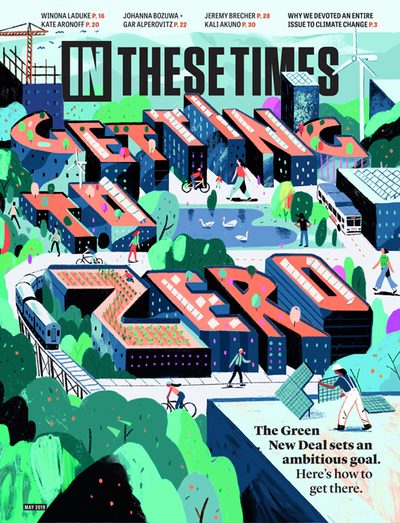What Will Our Climate-Ravaged World Look Like by 2049?
An author imagines how our lives will have changed in 30 years—and what we will have lost.
Meera Subramanian

I had just flown from an environmental humanities conference in Arizona on “Crafting the Long Tomorrow” to a family gathering in South India, where my father is from, when In These Times invited me to imagine what a zero-carbon society might look like should we achieve it by 2050. I decided to write a speculative letter to a close cousin, stepping into our shared, imagined future.
Dear Harish,
Hello, my sweet, faraway cousin-brother! As we approach our — gasp! — 80th birthdays, I felt inspired to resurrect the old tradition of letter writing.
It seems like yesterday we were sitting on your parents’ rooftop, taking in the night sounds of Besant Nagar, in the days when I would impulsively buy a ticket from Boston to Chennai without much of a thought beyond my bank account balance.
Remember when a ticket cost a few weeks’ pay instead of six months’? Has it really been 20 years since I last flew to India? I have forgotten the smell of the jasmine flowers women sold along the streets. Remind me again of their fragrance…
Do you see more stars now that the coal plants have shut down? Are the streets quieter without the roar of motorbikes? I suspect the electric vehicles still honk just as frequently and drive as wildly.
Perhaps everything is a little calmer, without the overwhelming crowds? But I imagine there’s an eeriness to that calm, knowing the cost at which it came.
When last I saw you, the future seemed so dark. Would we ever have believed that the United States and India would actually be poised to meet the 2050 zero-carbon goal? The Great Tumult of the ’30s still lay ahead, when all those climate report warnings started to play out like weekly cinema releases, when we finally abandoned the word “normal” when talking about the weather, when the (un)natural disasters and the spread of disease and the ticking up of temperature forever silenced the songs of so many, from the golden bush robins of the Himalayas to Nilakaran’s kids, and our dear aunt Devaki. It breaks me again, just thinking about that time.
We Americans played such a big role in the problem. Man, did you and I lead the good life those years in NYC! Really, Harish, did we even realize how decadent our lives had become? Every other month we were on a plane somewhere. I felt paralyzed about how to change the massive oil-infused infrastructure that made everything possible. I wanted to believe buying eco-friendly products and recycling would be enough. How foolish. Remember how I used to joke about using up the carbon footprint of the children I decided not to have? The joke falls flat now.
Speaking of the next generation, let me put aside my dark ruminations and bring you bright tidings of my stepkids. Their generation has made me reconsider my cynical belief that it’s human nature to consider your own needs first. I swear their brains are wired differently, like they can see the future in a way we just couldn’t.
The “girls” are middle-aged now. The eldest is still lawyering, fighting for citizenship for international climate refugees. My younger stepdaughter’s ethical clothing line is doing great. She never left Charlotte, N.C., where she went to school, one of those bustling inland cities. Her main store there teamed up with a shared workspace and a cafe, so the building is a community space as much as a shop. India’s model of small automated factories powered by a solar microgrid has really caught on here, and that’s what her company does. Everything they design, make and sell is sourced and manufactured locally. With everything so local, the kids can tell where someone’s from just by their clothes — her line has defined the “Carolina look.” And when the fabric is spent at the end of its life, her store welcomes returns, and they plug the material back into the production cycle.
Remember when cousin Pavi was working on this “circular economy” stuff in Mumbai, way back in the teens, when it was still kind of new? Around the same time China stopped taking the world’s plastic scraps—2018, was it? earlier? — and the global recycling system collapsed.
Sometimes I think this is the biggest change in our day-to-day lives since you and I last met, since we emerged from the darkness of the Tumult: Not only are people vastly more aware of how fragile human life is, and the slender skin that keeps this planet habitable, but we’re also so much more aware of all the things around us, these objects of our lives that are born from some form of life somewhere, be it a cotton plant or substances dug from the Earth’s strata. You always had a healthy relationship with your “stuff,” given your Buddhist tendencies, but you were rare in that respect. Now we’re all a little Buddhist, I guess, forced to detach from so much and simultaneously compelled to pay closer attention to what remains — human and nonhuman alike.
So the girls are doing great, but I have to admit I am glad I didn’t bring children into the world myself, despite my fear of regret. At first it was because I wanted to put my energy and limited money into nonprofit work, then journalism, and always travel. But eventually I felt like I couldn’t, in good conscience, look into the eyes of a child I knew would face a diminishing world, one without the old-growth forests I fell in love with as a girl, one so transformed by climate change. It was such luck to have met S— and his so-lovely daughters, to get to taste such family life beyond my own role as daughter-sistercousin. Back then, there were so few examples of how not to have children. It was seen as subversive instead of merely another way to be part of society. We didn’t realize we were setting a trend, did we?
S — ’s youngest has a child, though, doing well as she stands on the threshold of adulthood. Of course, like her entire generation, she’s traumatized by all she saw growing up during the Tumult — the flooding and drought, wildfires and storm surges — but somehow, she is still rooted in what I think of as the “place of possibility.” The young literally envision worlds we older folk can scarcely imagine. Sometimes I hear them talking about how this new economy will bring back the abundance of the last century (I’m reminded of the 1950s euphoria when a generation that grew up during the Depression experienced the post-WWII boom), and I wish they would listen when we tell them that we failed to buy our way into happiness, even as the Dow Jones shot up for two decades straight.
But I think they’re right to dismiss what we say. It is clear we failed them, failed to consider their futures, when we were young. They know this. And they’re trying harder, concerned with what they’re leaving behind, from clothing remnants to carbon dioxide. Does it feel that way in India, too?
This old lady is exhausted, Harish. I’ll continue tomorrow. …
Next day …
Ah, refreshed, at least as much as a 79-year-old can be.
So the move to Tennessee was a smart one. It took a few years, but we’re settled in now. We lost a lot of money on our old place in Cape Cod. It was just changing too fast, revealing itself to be the sandbar it always was with each new storm from the ever-lengthening hurricane season. But, with friends, we were able to scrape toget her enough to make it to the mecca that is this high plateau of the Southern Appalachians. There are 10 of us in the cluster home, built with the now-standard modified concrete and wood, designed to sequester carbon in the walls, along with solar roof tiles, a solar water heating system and only hyperefficient E+ appliances.
It can be challenging living with others — we were so used to our private single-family homes — but we have our own space within the building and the shared electric vehicle works well enough. And it saves all of us money. The best part, honestly, is the shared meals. Last night, someone made a delicious meal with veggies from the greenhouse and a hearty chickpea stew. We take turns cooking, and less cooking for each of us means more energy to experiment with all the new foods. (Are the strict vegetarian Brahmins trying out all the new beyond-beef products that are so popular here?) I don’t even miss meat anymore. Well, except for bacon.
S— is not as mobile as he once was, but when we do manage to go to visit the girls, the new national rail system is … wow, it’s just incredible. It’s slightly outrageous that it took America my entire lifetime to develop a train infrastructure that India had in the 1970s, when you and I were children and you could get anywhere in the country (even if it took days). To travel that last bit from the train station to wherever you’re going, there’s the FinalMile system, loaded with the selfdriving gizmos that still remind me of India’s auto rickshaws, minus the buzzy sputtering sound of the gas engine (well, and the missing driver).
Though there is a deep ache about not getting to wrap my arms around you and see all our relatives in India, or to smell the jasmine, there is, I admit, some part of me that feels almost a sense of relief now that I don’t need to spend the time, energy and money zipping my way across the world. I suspect others who jet-setted our days through the early part of the century might feel it, too, now that we simply can’t afford to fly. Screen visits feel so normal now. You can sense the shift in communities, too. There’s more focus on the local places we inhabit and the land we rely on together, like Wendell Berry was telling us all along.
Just writing all this, my mind is tumbling back again to when we were young, as it does so often these days. Remember how, in my early days of reporting, I wrote about the vultures that were on their way to extinction in India, back at the turn of the century? It was then I first realized what nimble creatures we humans are, for better and for worse. We have adjusted to the ever-shifting weather and stronger storms, our go-bags at the ready and battery backups always charged. Back then I wrote, “The vultures’ disappearance is catastrophic, yes, but the ability to adapt is stunning. Or terrifying. Or both. No matter how bad things get, how many species get wiped from the Earth … the living go on.”
And we do. But not all of us. It’s like a physical weight, my mourning for those who didn’t make it through the Tumult. Though we have found some planetary tranquility, we have done so at immeasurable cost. Forged by fire, eh?
It’s time to sign off, my dear Harish. There’s only one place to get this actual letter on a boat to you, which should depart tomorrow. I’m saving my pennies (so to speak — remember pennies?) so maybe I can book passage on that ship someday to see you, just once more. (Or there’s a place for you here, if you want to return). Should I make it, I’ll bury my nose in a bundle of jasmine and we can hobble up to a rooftop and remember a time when we thought the world couldn’t change, and then it did.
With Love,
Meera





